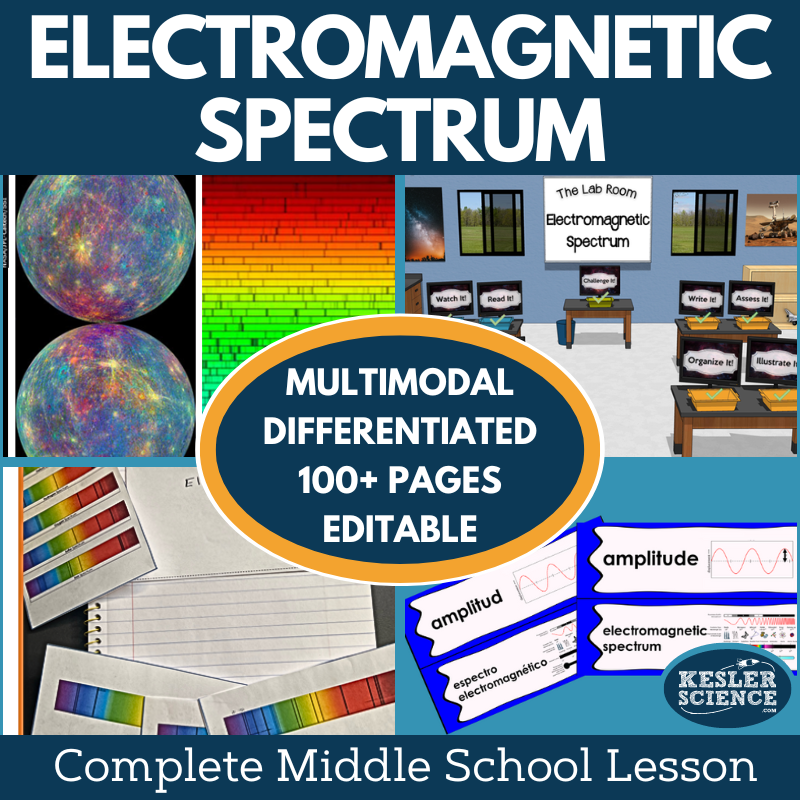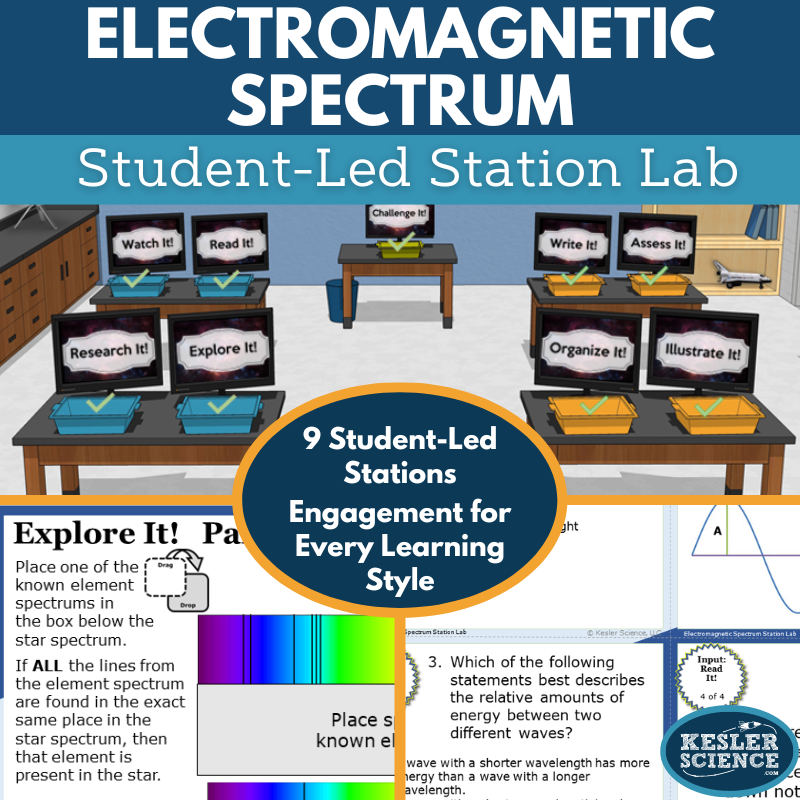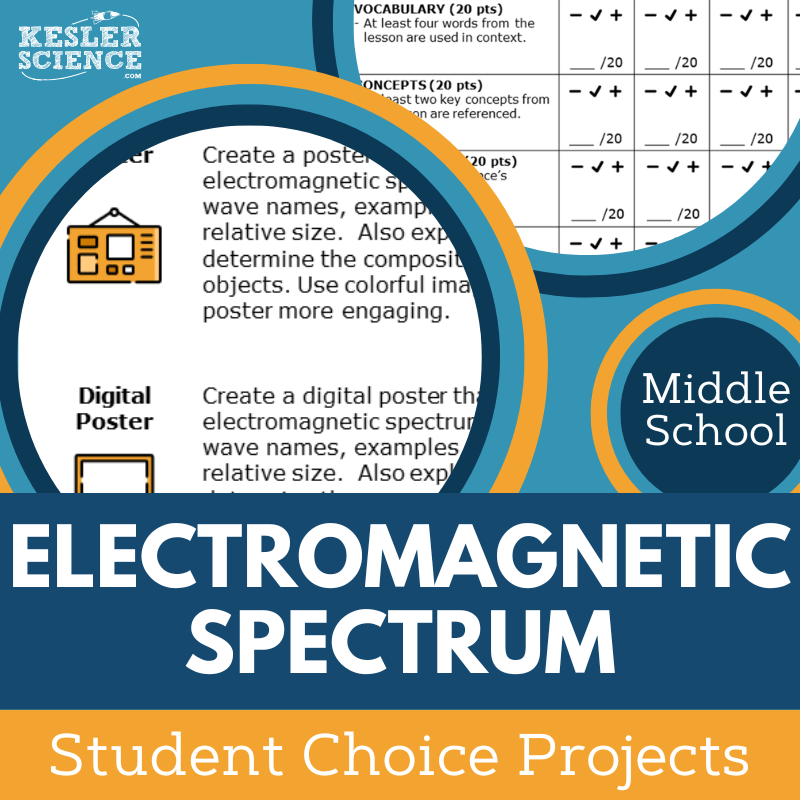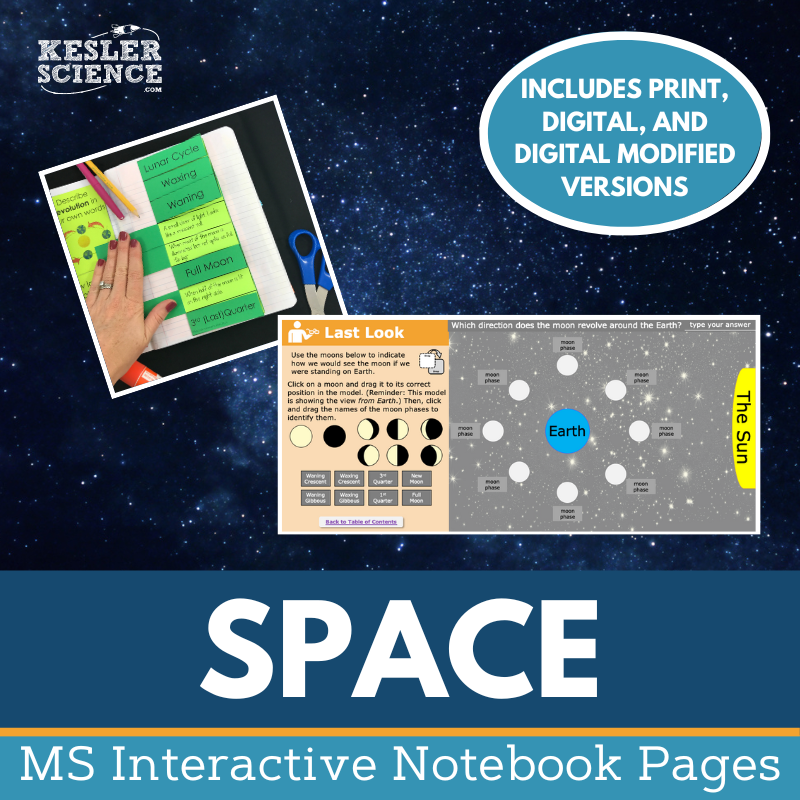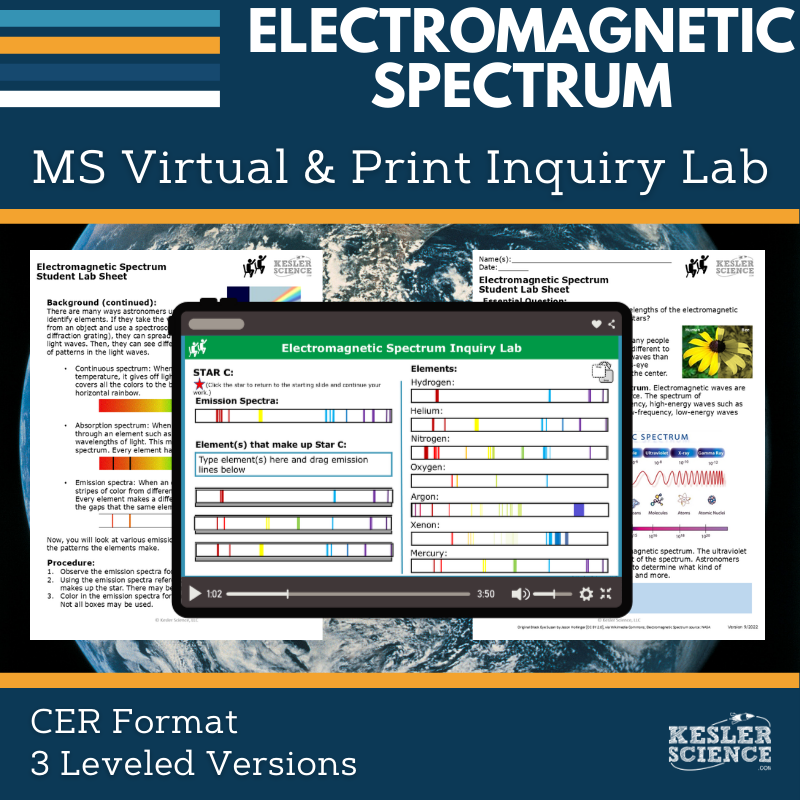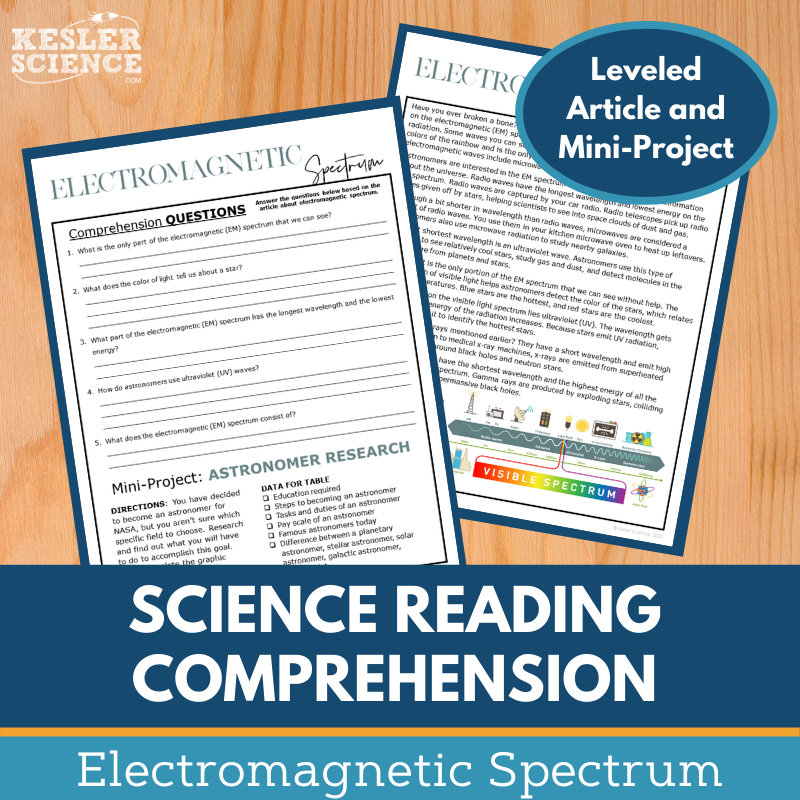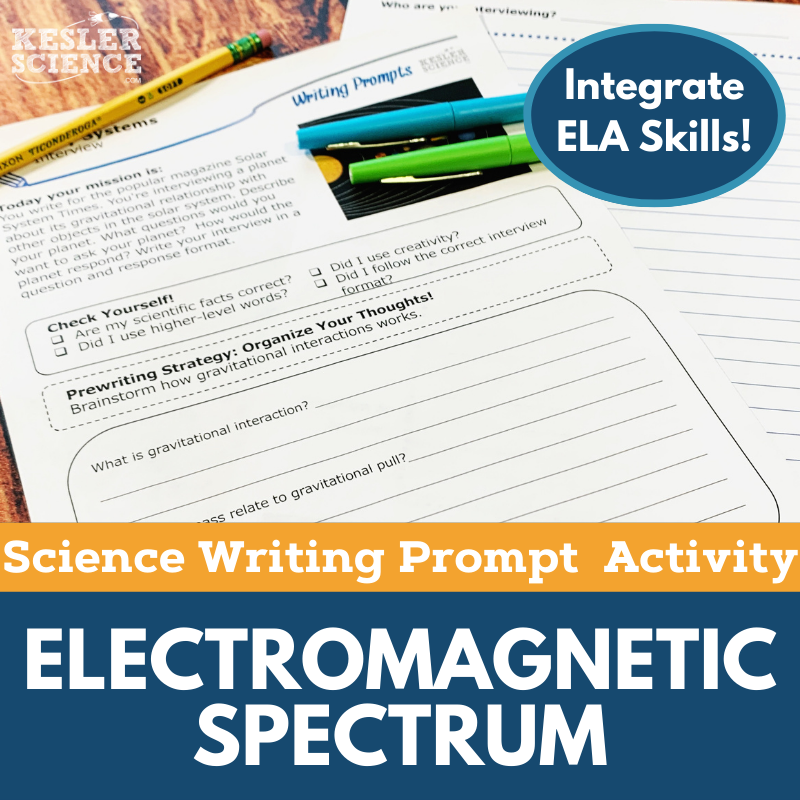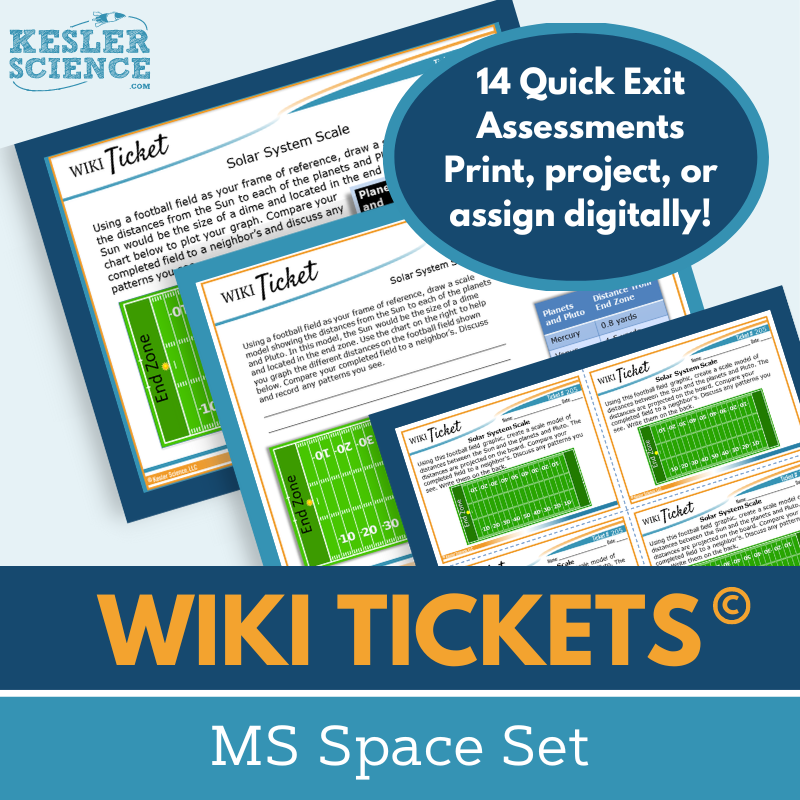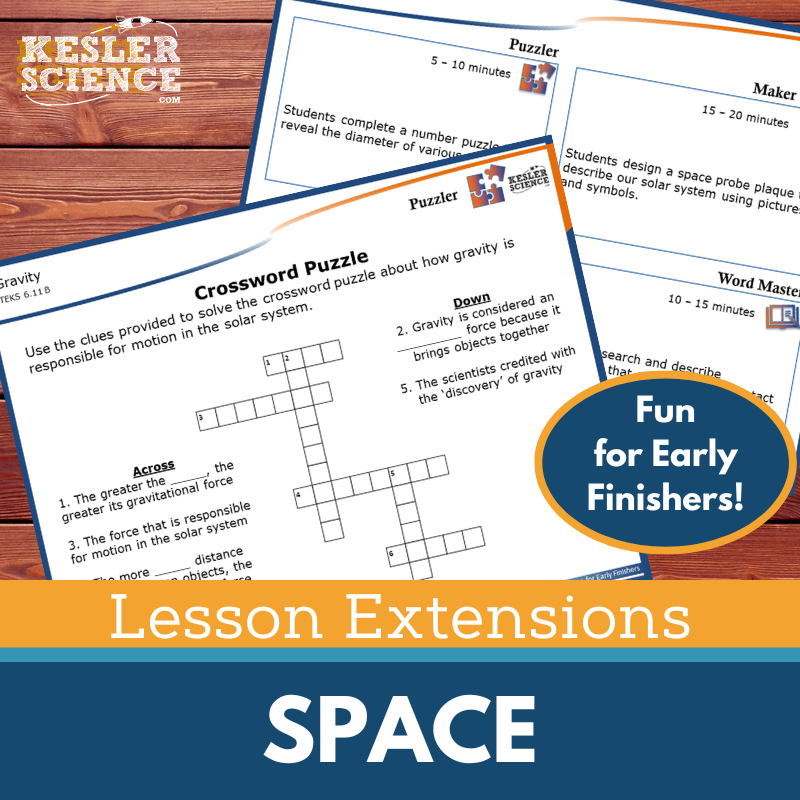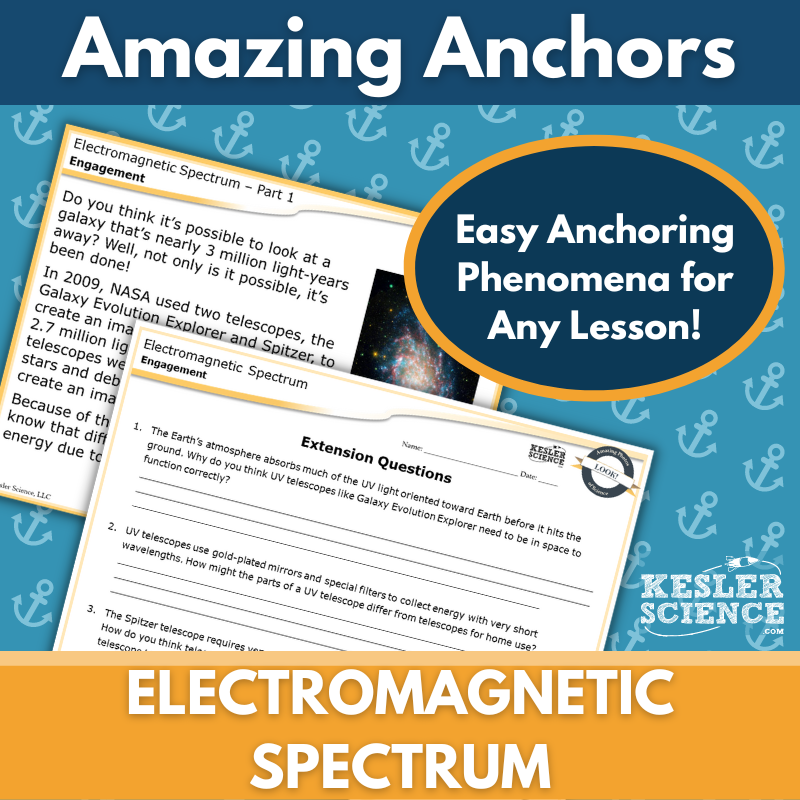Electromagnetic Spectrum Activities for Middle School Science
The Kesler Science Electromagnetic Spectrum 5E Lesson is a low-prep, student-centered unit that helps middle school students explore what the electromagnetic spectrum is, how we know what stars are made of, and how we determine their distance from Earth. The resources below will give students a comprehensive understanding of the electromagnetic spectrum. All of the following materials are also included in the Kesler Science Membership.
The Kesler Science Electromagnetic Spectrum 5E Lesson is an engaging, student-centered unit. It helps middle school students explore essential questions like the composition of stars, their distance from Earth, and the nature of the electromagnetic spectrum. The unit includes editable presentations, interactive notebooks, vocabulary supports in English and Spanish, worksheets, assessments, and student-choice projects, all designed for differentiated, low-prep instruction suitable for classroom or virtual settings.
Following the 5E Model, the lesson begins with engaging vocabulary activities and teacher-guided discussions. The exploration phase features a nine-station lab that supports multimodal learning styles through demos, readings, videos, websites, and differentiated input/output tasks. Students illustrate, sort, write, and assess their understanding, with a bonus challenge station included for enrichment. Explanation resources include editable PowerPoints and digital or printable interactive notebook pages in English and Spanish.
To deepen learning, elaboration is supported by student-choice projects, while evaluation includes STAAR 2.0-aligned assessments and review materials in multiple formats. The lesson's flexibility, support for various learners, and comprehensive structure make it a powerful tool for helping students master the electromagnetic spectrum.
The Kesler Science Electromagnetic Spectrum 5E Lesson is an engaging, student-centered unit. It helps middle school students explore essential questions like the composition of stars, their distance from Earth, and the nature of the electromagnetic spectrum. The unit includes editable presentations, interactive notebooks, vocabulary supports in English and Spanish, worksheets, assessments, and student-choice projects, all designed for differentiated, low-prep instruction suitable for classroom or virtual settings.
Following the 5E Model, the lesson begins with engaging vocabulary activities and teacher-guided discussions. The exploration phase features a nine-station lab that supports multimodal learning styles through demos, readings, videos, websites, and differentiated input/output tasks. Students illustrate, sort, write, and assess their understanding, with a bonus challenge station included for enrichment. Explanation resources include editable PowerPoints and digital or printable interactive notebook pages in English and Spanish.
To deepen learning, elaboration is supported by student-choice projects, while evaluation includes STAAR 2.0-aligned assessments and review materials in multiple formats. The lesson's flexibility, support for various learners, and comprehensive structure make it a powerful tool for helping students master the electromagnetic spectrum.
This student-led station lab on the electromagnetic spectrum is a low-prep, high-engagement activity designed to help middle school students explore factors that affect the strength of electric and magnetic forces. The lab includes nine modular stations—eight core tasks and one bonus challenge—offering differentiated, multimodal activities that empower students to guide their own learning. Stations are suitable for individual or small group work and are fully compatible with in-class or virtual environments using PowerPoint or Google Slides.
The lab is organized into input and output stations. Input stations—Explore It!, Read It!, Research It!, and Watch It!—introduce content through hands-on demonstrations, readings with differentiated passages in English and Spanish, educational websites, and videos. Output stations—Organize It!, Illustrate It!, Write It!, and Assess It!—allow students to demonstrate understanding through interactive sorting, drawing, writing, and vocabulary assessments. A Challenge It! station offers games, crosswords, and mini-projects for early finishers seeking enrichment.
All necessary signage, readings, websites, and task cards are included for ease of use. This lab is part of the larger Electromagnetic Spectrum 5E Lesson Plan but can be used independently.
This student-led station lab on the electromagnetic spectrum is a low-prep, high-engagement activity designed to help middle school students explore factors that affect the strength of electric and magnetic forces. The lab includes nine modular stations—eight core tasks and one bonus challenge—offering differentiated, multimodal activities that empower students to guide their own learning. Stations are suitable for individual or small group work and are fully compatible with in-class or virtual environments using PowerPoint or Google Slides.
The lab is organized into input and output stations. Input stations—Explore It!, Read It!, Research It!, and Watch It!—introduce content through hands-on demonstrations, readings with differentiated passages in English and Spanish, educational websites, and videos. Output stations—Organize It!, Illustrate It!, Write It!, and Assess It!—allow students to demonstrate understanding through interactive sorting, drawing, writing, and vocabulary assessments. A Challenge It! station offers games, crosswords, and mini-projects for early finishers seeking enrichment.
All necessary signage, readings, websites, and task cards are included for ease of use. This lab is part of the larger Electromagnetic Spectrum 5E Lesson Plan but can be used independently.
The Kesler Science Electromagnetic Spectrum Student Choice Projects empower middle school students to showcase their learning in ways that suit their individual styles. With six project options and a "design your own" feature, students explore creative, student-led approaches to demonstrate their understanding. A flexible grading rubric supports assessments by teachers, peers, or students themselves.
Designed for flexibility, this resource includes nine project choices, teacher guidance, and editable rubric pages. Differentiation options make it accessible to students needing extra support, while advanced learners can take on additional challenges. Teachers can customize the projects and rubrics to align with classroom goals.
The projects require minimal supplies, relying on common classroom materials like paper, markers, and scissors, with digital options available for many activities. This versatile format ensures all students can engage meaningfully, whether in a traditional classroom or virtual learning environment.
The Kesler Science Electromagnetic Spectrum Student Choice Projects empower middle school students to showcase their learning in ways that suit their individual styles. With six project options and a "design your own" feature, students explore creative, student-led approaches to demonstrate their understanding. A flexible grading rubric supports assessments by teachers, peers, or students themselves.
Designed for flexibility, this resource includes nine project choices, teacher guidance, and editable rubric pages. Differentiation options make it accessible to students needing extra support, while advanced learners can take on additional challenges. Teachers can customize the projects and rubrics to align with classroom goals.
The projects require minimal supplies, relying on common classroom materials like paper, markers, and scissors, with digital options available for many activities. This versatile format ensures all students can engage meaningfully, whether in a traditional classroom or virtual learning environment.
The Kesler Science Space Science Interactive Notebook is an engaging resource for teachers looking to create interactive learning experiences for their students. It includes both print and digital versions, making it perfect for traditional classrooms, 1:1 environments, or distance learning.
The bundle covers key space science topics such as asteroids, meteors, and comets, the Big Bang theory, eclipses, the electromagnetic spectrum, galaxies, and more. The digital version features a PowerPoint interactive notebook, which can be uploaded to Google Slides or learning management systems like MS Teams or Canvas. Reflection pages and space for students to take notes are included, along with a teacher answer key and modified versions for students with accommodations.
The print version provides a full set of blank templates for students, pre-filled templates for those needing modifications, and color photos to illustrate how each template should be used. This bundle is designed to support differentiated learning and keep students engaged in key space science concepts.
The Kesler Science Space Science Interactive Notebook is an engaging resource for teachers looking to create interactive learning experiences for their students. It includes both print and digital versions, making it perfect for traditional classrooms, 1:1 environments, or distance learning.
The bundle covers key space science topics such as asteroids, meteors, and comets, the Big Bang theory, eclipses, the electromagnetic spectrum, galaxies, and more. The digital version features a PowerPoint interactive notebook, which can be uploaded to Google Slides or learning management systems like MS Teams or Canvas. Reflection pages and space for students to take notes are included, along with a teacher answer key and modified versions for students with accommodations.
The print version provides a full set of blank templates for students, pre-filled templates for those needing modifications, and color photos to illustrate how each template should be used. This bundle is designed to support differentiated learning and keep students engaged in key space science concepts.
The Electromagnetic Spectrum Inquiry Lab aligns with NGSS by helping students explore how astronomers use different wavelengths of the electromagnetic spectrum to determine the composition of stars. Students will analyze and compare types of spectra—continuous, absorption, and emission—using reference data to reproduce the spectral patterns of various stars.
This lab includes both digital and print versions, offering flexibility for any classroom setup. Each format features comprehension questions, Claim-Evidence-Reasoning (C.E.R.) prompts, and a reflection section. Differentiated versions are included to support all learners: a structured version with sentence stems for modified instruction, a guided version for on-level learners, and a student-directed version for advanced learners.
Standard classroom materials like colored pencils and a spectra reference page are used in the print lab, while the digital version requires no additional materials and is fully interactive through PowerPoint or Google Slides. Teacher resource pages, editable files, and answer keys are included to simplify planning and grading.
The Electromagnetic Spectrum Inquiry Lab aligns with NGSS by helping students explore how astronomers use different wavelengths of the electromagnetic spectrum to determine the composition of stars. Students will analyze and compare types of spectra—continuous, absorption, and emission—using reference data to reproduce the spectral patterns of various stars.
This lab includes both digital and print versions, offering flexibility for any classroom setup. Each format features comprehension questions, Claim-Evidence-Reasoning (C.E.R.) prompts, and a reflection section. Differentiated versions are included to support all learners: a structured version with sentence stems for modified instruction, a guided version for on-level learners, and a student-directed version for advanced learners.
Standard classroom materials like colored pencils and a spectra reference page are used in the print lab, while the digital version requires no additional materials and is fully interactive through PowerPoint or Google Slides. Teacher resource pages, editable files, and answer keys are included to simplify planning and grading.
This Electromagnetic Spectrum Science Reading Comprehension Lesson engages middle school students with a nonfiction article that explores different wavelengths of the electromagnetic spectrum and how they help scientists learn about the universe. After reading, students answer comprehension questions and complete a research activity comparing different types of astronomers.
The resource includes two leveled reading passages with Lexile ranges between 1100–1300, making it appropriate for grades 6–8 and advanced 5th graders. Students complete five to seven comprehension questions and an interactive, hands-on mini-project. A Cornell notes template is also included to support note-taking, and the content features colorful graphics that print well in grayscale.
Ideal for both in-person and virtual settings, the materials are compatible with platforms like Google Classroom and Schoology. This resource supports science literacy, is great for sub plans or enrichment, and encourages classroom discussion while reinforcing comprehension and analysis skills.
This Electromagnetic Spectrum Science Reading Comprehension Lesson engages middle school students with a nonfiction article that explores different wavelengths of the electromagnetic spectrum and how they help scientists learn about the universe. After reading, students answer comprehension questions and complete a research activity comparing different types of astronomers.
The resource includes two leveled reading passages with Lexile ranges between 1100–1300, making it appropriate for grades 6–8 and advanced 5th graders. Students complete five to seven comprehension questions and an interactive, hands-on mini-project. A Cornell notes template is also included to support note-taking, and the content features colorful graphics that print well in grayscale.
Ideal for both in-person and virtual settings, the materials are compatible with platforms like Google Classroom and Schoology. This resource supports science literacy, is great for sub plans or enrichment, and encourages classroom discussion while reinforcing comprehension and analysis skills.
The Kesler Science Electromagnetic Spectrum Science Writing Prompt Activity engages middle school students with a news event reporting format, helping them test their knowledge and refine their science reasoning skills. This creative and student-centered activity enriches writing while reinforcing concepts related to the electromagnetic spectrum. Designed for maximum flexibility, it supports both in-person and virtual learning environments, keeping students engaged and exploring science from anywhere.
This resource includes teacher directions, an answer guide, and full or half-sheet rubrics for grading flexibility. Students benefit from full-sized or half-sheet handouts for their interactive notebooks, pre-writing strategies, and layout templates, all available in printable and digital formats. The included PowerPoint version can be seamlessly integrated into platforms like Google Slides for easy virtual use.
With versatile applications, the activity can be used for pre-test assessments, cross-curricular learning, student choice projects, extra credit, or differentiation exercises. Whether as a standalone lesson or in conjunction with other Kesler Science resources, this writing prompt activity delivers high-quality, low-prep opportunities to inspire and challenge your students.
The Kesler Science Electromagnetic Spectrum Science Writing Prompt Activity engages middle school students with a news event reporting format, helping them test their knowledge and refine their science reasoning skills. This creative and student-centered activity enriches writing while reinforcing concepts related to the electromagnetic spectrum. Designed for maximum flexibility, it supports both in-person and virtual learning environments, keeping students engaged and exploring science from anywhere.
This resource includes teacher directions, an answer guide, and full or half-sheet rubrics for grading flexibility. Students benefit from full-sized or half-sheet handouts for their interactive notebooks, pre-writing strategies, and layout templates, all available in printable and digital formats. The included PowerPoint version can be seamlessly integrated into platforms like Google Slides for easy virtual use.
With versatile applications, the activity can be used for pre-test assessments, cross-curricular learning, student choice projects, extra credit, or differentiation exercises. Whether as a standalone lesson or in conjunction with other Kesler Science resources, this writing prompt activity delivers high-quality, low-prep opportunities to inspire and challenge your students.
The Kesler Science Space WIKI Tickets are engaging formative assessments designed for 6th-8th grade science topics, offering multiple flexible formats to check student understanding. Each topic in the Space Set includes five versions: full-screen display, three handout sizes (full, split, and quarter-page), and a digital interactive option that can be used as an editable PowerPoint or Google Slides file.
These assessments are aligned with NGSS and TEKS middle school science standards, with some topics featuring multiple tickets. Each set also includes a bonus table of contents file to show standard alignment, ensuring a comprehensive understanding of the covered topics.
Perfect for both in-class and remote learning, WIKI Tickets can be used as exit tickets, bellringers, or anytime you need to gauge students' progress. Whether projected on a screen or completed digitally, these colorful and engaging assessments provide valuable insight into student comprehension of key space science topics such as the lunar cycle, solar system properties, and space exploration.
The Kesler Science Space WIKI Tickets are engaging formative assessments designed for 6th-8th grade science topics, offering multiple flexible formats to check student understanding. Each topic in the Space Set includes five versions: full-screen display, three handout sizes (full, split, and quarter-page), and a digital interactive option that can be used as an editable PowerPoint or Google Slides file.
These assessments are aligned with NGSS and TEKS middle school science standards, with some topics featuring multiple tickets. Each set also includes a bonus table of contents file to show standard alignment, ensuring a comprehensive understanding of the covered topics.
Perfect for both in-class and remote learning, WIKI Tickets can be used as exit tickets, bellringers, or anytime you need to gauge students' progress. Whether projected on a screen or completed digitally, these colorful and engaging assessments provide valuable insight into student comprehension of key space science topics such as the lunar cycle, solar system properties, and space exploration.
The Kesler Science Space Lesson Extensions provide engaging activities designed to challenge fast finishers and deepen student learning. These critical thinking tasks are connected to NGSS and TEKS space standards, offering rigorous but fun opportunities to explore topics in greater depth. With activities like puzzles, hands-on maker space tasks, tech connections, and creative word writing, these extensions promote STEAM skills and digital literacy.
The Lesson Extensions are structured to provide flexible support for teachers, with clear directions, answer keys, and both digital and paper versions. These materials help reinforce the lesson’s core concepts while offering ways to engage students during testing or other gaps in the schedule.
Perfect for independent learners, these activities push students to apply their knowledge creatively while connecting it to real-world applications. The extensions cover a variety of space science topics, including gravity, space travel, and the lunar cycle, providing additional challenges that extend the learning experience beyond the standard lesson.
The Kesler Science Space Lesson Extensions provide engaging activities designed to challenge fast finishers and deepen student learning. These critical thinking tasks are connected to NGSS and TEKS space standards, offering rigorous but fun opportunities to explore topics in greater depth. With activities like puzzles, hands-on maker space tasks, tech connections, and creative word writing, these extensions promote STEAM skills and digital literacy.
The Lesson Extensions are structured to provide flexible support for teachers, with clear directions, answer keys, and both digital and paper versions. These materials help reinforce the lesson’s core concepts while offering ways to engage students during testing or other gaps in the schedule.
Perfect for independent learners, these activities push students to apply their knowledge creatively while connecting it to real-world applications. The extensions cover a variety of space science topics, including gravity, space travel, and the lunar cycle, providing additional challenges that extend the learning experience beyond the standard lesson.
This Amazing Anchors Phenomenon Lesson introduces the electromagnetic spectrum through a real-world connection to NASA telescopes. Students begin with an engaging reading that explores how telescopes detect different types of electromagnetic waves. Comprehension and extension questions help build curiosity and activate prior knowledge before diving deeper into the science.
The second reading breaks down how telescopes work and explains the electromagnetic spectrum in accessible language. Reinforcement and comprehension questions extend learning and support student understanding. Designed to fit the Engagement and Elaborate phases of the 5E model, these readings effectively bookend any main lesson on light waves and space science.
The lesson includes teacher directions, answer keys, editable PowerPoint slides, and both full- and half-sheet printables. Digital and paper formats are available, making it easy to use in any setting. Differentiated materials are provided, including a modified version with simplified language and sentence starters to support diverse learners.
This Amazing Anchors Phenomenon Lesson introduces the electromagnetic spectrum through a real-world connection to NASA telescopes. Students begin with an engaging reading that explores how telescopes detect different types of electromagnetic waves. Comprehension and extension questions help build curiosity and activate prior knowledge before diving deeper into the science.
The second reading breaks down how telescopes work and explains the electromagnetic spectrum in accessible language. Reinforcement and comprehension questions extend learning and support student understanding. Designed to fit the Engagement and Elaborate phases of the 5E model, these readings effectively bookend any main lesson on light waves and space science.
The lesson includes teacher directions, answer keys, editable PowerPoint slides, and both full- and half-sheet printables. Digital and paper formats are available, making it easy to use in any setting. Differentiated materials are provided, including a modified version with simplified language and sentence starters to support diverse learners.
Year-Round Resources
These year-round activities will increase your students' understanding of many middle school science topics. All of these activities are also included in the Kesler Science Membership.
Visual Data & Graphing
You're not alone if your students struggle with understanding graphs, charts, and tables. It's a skill that takes an enormous amount of practice. This resource will help students build a strong foundation in analyzing data and creating their own data visualizations.
Bell Ringers and Warm-Ups
These middle school science bell ringers are an excellent way to engage your students as soon as they walk into your classroom. This comprehensive FULL YEAR resource includes everything you need to start off each science class with an interesting warm-up activity.
Review Board Games
Each game board has been carefully designed to keep students engaged. There are 10 different action spaces on each board and dozens of question cards. All of the actions are related to science concepts and keep the students motivated throughout the game.
Each game is ready to play. Simply print out the board and the cards and let the students enjoy reviewing nine different units.
Essential Questions
Below are the essential questions associated with the lessons and activities included in this unit. This topic is only one of more than 100 middle school science topics included in the Kesler Science Membership.
-
How do we know what stars are composed of?
-
How do we know how far stars are from Earth?
-
What is the Electromagnetic Spectrum (EMS)?
Kesler Science Membership
Imagine never having to search for another middle school science lesson again. The membership gives you access to ALL of the Kesler Science products in one place (Yes, including everything above).
Say goodbye to long hours of lesson prep.

